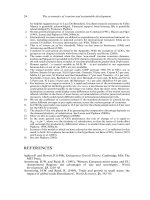THE ECONOMICS OF MONEY,BANKING, AND FINANCIAL MARKETS 398
Bạn đang xem bản rút gọn của tài liệu. Xem và tải ngay bản đầy đủ của tài liệu tại đây (52.32 KB, 1 trang )
366
PA R T I V
The Management of Financial Institutions
Profit ($)
12 000
Profit ($)
12 000
Buyer of
Futures
Buyer of
Call Option
10 000
8000
10 000
8000
D
6000
6000
4000
4000
C
2000
0
2000
110 115 120 125
A
B
Price of
Futures
Contract at
Expiration ($)
2000
0
A
110 115 120 125
Buyer of
2000
B
4000
4000
6000
6000
8000
8000
10 000
10 000
12 000
Loss ($)
12 000
Loss ($)
(a) Profit or loss for
buyer of call option
and buyer of futures
F I G U R E 14 - 3
Price of Futures
Contract at
Expiration ($)
C
D Put Option
Seller of
Futures
(b) Profit or loss for
buyer of put option
and seller of futures
Profits and Losses on Options Versus Futures Contracts
The futures contract is the $100 000 June Canada bond contract, and the option contracts are
written on this futures contract with an exercise price of 115. Panel (a) shows the profits and
losses for the buyer of the call option and the buyer of the futures contract, and panel (b) shows
the profits and losses for the buyer of the put option and the seller of the futures contract.
exercising the option minus the $2000 premium), plotted as point D. Plotting
these points, we get the kinked profit curve for the call option that we see
in panel (a).
Suppose that instead of purchasing the futures option contract in February,
Irving decides to buy the $100 000 June Canada bond futures contract at the
price of 115. If the price of the bond on the expiration day at the end of June
declines to 110, meaning that the price of the futures contract also falls to 110,
Irving suffers a loss of 5 percentage points, or $5000. The loss of $5000 on the
futures contract at a price of 110 is plotted as point A* in panel (a). At a price
of 115 on the expiration date, Irving would have a zero profit on the futures
contract, plotted as point B*. At a price of 120, Irving would have a profit on the
contract of 5 percentage points, or $5000 (point C*), and at a price of 125, the
profit would be 10 percentage points, or $10 000 (point D*). Plotting these
points, we get the linear (straight-line) profit curve for the futures contract that
appears in panel (a).









